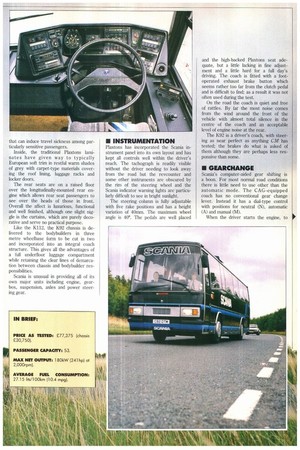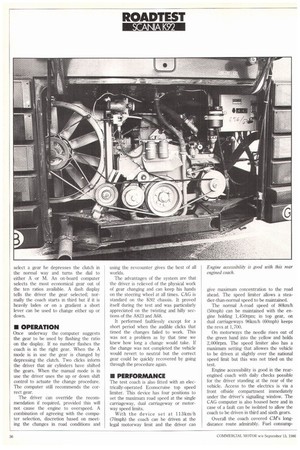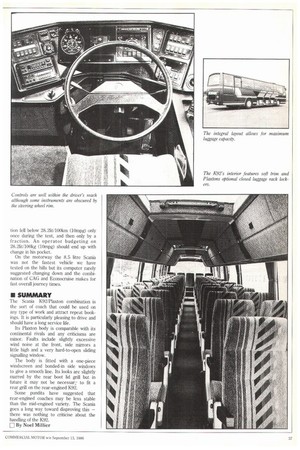SMOOTH AND EFFI CIENT
Page 36

Page 37

Page 38

Page 39

If you've noticed an error in this article please click here to report it so we can fix it.
Easy to drive, with CAG, comfortable to ride in with acceptable performance and fuel economy — Scania's K92 coach has a lot to offer
• This year coach operators are placing more emphasis on less exotic middle-ofthe-road coaches than on the highfloor ultra high specification machines that grew in popularity during the short-lived shuttle boom.
The rapid rise in popularity of the air sprung super coaches, however, has increased passenger expectations and many now expect the quiet comfort of top class travel for everyday excursions.
Scania's K series chassis are winning an increasing share of the market. In particular its powerful K112 has become established with operators still operating on long distance shuttles and the like.
Some, however, might consider its premium specification a little too premium for the everyday coaching role.
For these Scania offers the less powerful 1{92 which, with a normal height, fully-seated coach body, is likely to prove well suited to all types of coach operation including local contract work and top class touring. With the luggage capacity offered by its rear-engined inte
gral layout, it is also suitable for shuttle work should demand materialise.
We have just road tested a Scalia K92 on our revised Scottish test route and found it a particularly relaxing vehicle to both ride in and drive.
The coach is a full 12 metres fitted with a two star specification Plaxtons Paramount 3,200 coach body with 53 reclining seats. The K92 is powered by Scarnia's DS903 8.5 litre turbocharged engine and features computer-aided gear changing as standard.
Scania has been using the coach as a demonstration vehicle and it was well run in at the time of the test with around 45,000km on the clock. It has since been sold to Maidstone Borough Council in Kent.
The body specification includes luggage rack locker doors, radial windscreen wipers, an oil-fired Eberspacher heater and timer and a courier seat as optional extras. The Plaxtons two star package includes a power-operated pivot mount entrance door and full soft trim as standard. A centre aisle carpet is also fitted.
For the driver the Scania is very attractive. It handles well and is more predictable and stable than some mid-engined vehicles we have tried. The driving position is good. The K92 is not/fitted with the currently-fashionable low driver front end and we appreciated the road safety advantages of the view afforded by placing the driver on the same level as the passenger deck.
• PASSENGER COMFORT
For the passengers the ride is good. The full air suspension copes admirably with pot holes without the rolling and dipping sometimes associated with air suspension that can induce travel sickness among particularly sensitive passengers.
Inside, the traditional Plaxtons laminates have given way to typically European soft trim in restful warm shades of grey with carpet-type materials covering the roof lining, luggage racks and locker doors.
The rear seats are on a raised floor over the longitudinally-mounted rear engine which allows rear seat passengers to see over the heads of those in front. Overall the affect is luxurious, functional and well finished, although one slight niggle is the curtains, which are purely decorative and serve no practical purpose.
Like the K112, the K92 chassis is delivered to the bodybuilders in three metre wheelbase form to be cut in two and incorporated into an integral coach structure. This gives all the advantages of a full underfloor luggage compartment while retaining the clear lines of demarcation between chassis and bodybuilder responsibilities.
Scania is unusual in providing all of its own major units including engine, gearbox, suspension, axles and power steering gear.
• INSTRUMENTATION
Plaxtons has incorporated the Scania instrument panel into its own layout and has kept all controls well within the driver's reach. The tachograph is readily visible without the driver needing to look away from the road but the revcounter and some other instruments are obscured by the rim of the steering wheel and the Scania indicator warning lights are particularly difficult to see in bright sunlight.
The steering column is fully adjustable with five rake positions and has a height variation of 40mm. The maximum wheel angle is 40°. The pedals are well placed and the high-backed Plaxtons seat adequate, but a little lacking in fine adjustment and a little hard for a full day's driving. The coach is fitted with a footoperated exhaust brake button which seems rather too far from the clutch pedal and is difficult to find; as a result it was not often used during the test.
On the road the coach is quiet and free of rattles. By far the most noise comes from the wind around the front of the vehicle with almost total silence in the centre of the coach and an acceptable level of engine noise at the rear.
The K92 is a driver's coach, with steering as near perfect as anything CM has tested; the brakes do what is asked of them although they are perhaps less responsive than some.
• GEARCHANGE
Scania's computer-aided gear shifting is a boon. For most normal road conditions there is little need to use other than the automatic mode. The CAG-equipped coach has no conventional gear change lever. Instead it has a dial-type control with positions for neutral (N), automatic (A) and manual (M).
When the driver starts the engine, to select a gear he depresses the clutch in the normal way and turns the dial to either A or M. An on-board computer selects the most economical gear out of the ten ratios available. A dash display tells the driver the gear selected; normally the coach starts in third but if it is heavily laden or on a gradient a short lever can be used to change either up or down.
• OPERATION
Once underway the computer suggests the gear to be used by flashing the ratio on the display. If no number flashes the coach is in the right gear. When the A mode is in use the gear is changed by depressing the clutch. Two clicks inform the driver that air cylinders have shifted the gears. When the manual mode is in use the driver uses the up or down shift control to actuate the change procedure. The computer still recommends the correct gear.
The driver can override the recommendation if required, provided this will not cause the engine to overspeed. A combination of agreeing with the computer selection, discretion based on meeting the changes in road conditions and using the revcounter gives the best of all worlds.
The advantages of the system are that the driver is relieved of the physical work of gear changing and can keep his hands on the steering wheel at all times. CAG is standard on the K92 chassis. It proved itself during the test and was particularly appreciated on the twisting and hilly sections of the A823 and A68.
It performed faultlessly except for a short period when the audible clicks that timed the changes failed to work. This was not a problem as by that time we knew how long a change would take. If the change was not completed the vehicle would revert to neutral but the correct gear could be quickly recovered by going through the procedure again.
• PERFORMANCE
The test coach is also fitted with an electrically-operated Econocruise top speed limiter. This device has four positions to set the maximum road speed at the single carriageway, dual carriageway or motorway speed limits.
With the device set at 113km/h (70rriph) the coach can be driven at the legal motorway limit and the driver can Engine accessibility is good with this rear en,gined coach.
give maximum concentration to the road ahead. The speed limiter allows a steadier-than-normal speed to be maintained.
The normal A-road speed of 80km/h (50mph) can be maintained with the engine holding 1,450rpm; in top gear, on dual carriageways 96km/h (60mph) keeps the revs at 1,700.
On motorways the needle rises out of the green band into the yellow and holds 2,000rpm. The speed limiter also has a maximum setting that allowes the vehicle to be driven at slightly over the national speed limit but this was not tried on the test.
Engine accessibility is good in the rearengined coach with daily checks possible for the driver standing at the rear of the vehicle. Access to the electrics is via a front offside compartment immediately under the driver's signalling window. The CAG computer is also housed here and in case of a fault can be isolated to allow the coach to be driven in third and sixth gears.
Overall the coach covered CM's longdistance route admirably. Fuel consump
tion fell below 28.21it/100km (10mpg) only once during the test, and then only by a fraction. An operator budgeting on 28.21it/100kg (10mpg) should end up with change in his pocket.
On the motorway the 8.5 litre Scalia was not the fastest vehicle we have tested on the hills but its computer rarely suggested changing down and the combination of CAG and Econocruise makes for fast overall journey times.
• SUMMARY
The Scania K92/Plaxton combination is the sort of coach that could be used on any type of work and attract repeat bookings. It is particularly pleasing to drive and should have a long service life.
Its Plaxton body is comparable with its continental rivals and any criticisms are minor. Faults include slightly excessive wind noise at the front, side mirrors a little high and a very hard-to-open sliding signalling window.
The body is fitted with a one-piece windscreen and bonded-in side windows to give a smooth line. Its looks are slightly marred by the rear boot lid grill but in future it may not be necessar; to fit a rear grill on the rear-engined K92.
Some pundits have suggested that rear-engined coaches may be less stable than the mid-engined variety. The Scania goes a long way toward disproving this — there was nothing to criticise about the handling of the K92.
[1] By Noel Millier




























































































